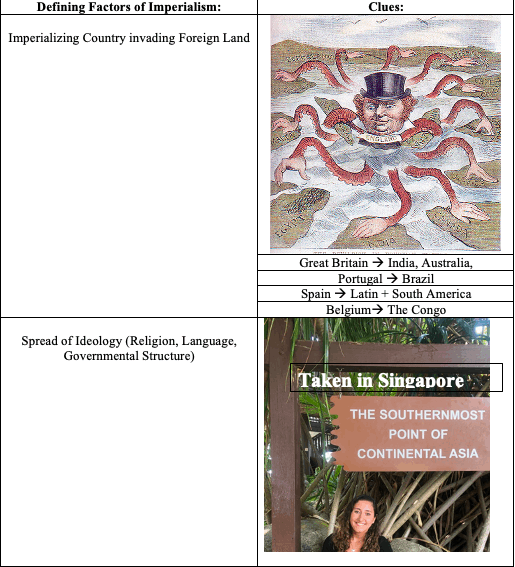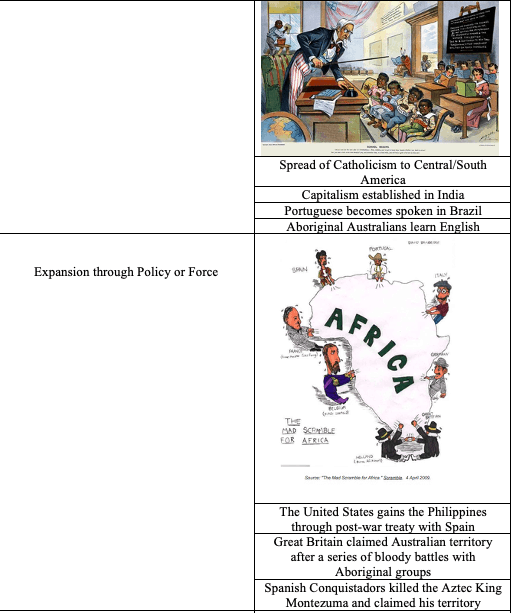“In working to formulate a solution, students naturally build their skills in collecting evidence, organizing and interpreting information, and developing logical hypotheses and explanations. In addition, because the Mystery strategy capitalizes on the human affinity for the intriguing and perplexing, it arouses student curiosity and increases motivation in any classroom” (Silver, Strong, & Perini, 2007, p. 107).
Silver, H. F., Strong, R. W., & Perini, M. J. (2007). The Strategic Teacher: Selecting the Right Research-Based Strategy for Every Lesson. Alexandria, VA: ASCD.
Target Audience and Setting: This lesson is designed for a 9th grade Modern World History Class. It is the introductory lesson to a unit on “Colonialism in the Congo,” which uses the example of Belgian imperialism in the Congo as a case study on the effects of colonization, especially leading up to WWI. Later in the units, students will connect the concept of imperialism and its characteristics to a country of their own choosing, illustrating the impacts of colonialism in the modern day.
Content: In this lesson, students will be introduced to the concept of imperialism, including its key characteristics and typical structure. Students will also be briefly introduced to the Belgians in the Congo as a case study of imperialism. This is important because imperialism was such a far-reaching system that has affected the present situation of many countries throughout the world, including our own. The Congo was a particularly violent example of imperialism that illustrates the harms and lasting damages inflicted by imperialism.
Process: I will be using an activity from Silver, Strong, & Perini’s 2007 book Strategic Teacher: Selecting the Right Research-Based Strategy for Every Lesson. The strategy I am using is called “Mystery,” and it requires the students to act as detectives and sort through clues to solve a key question.
- Ask the key mystery question, “What are the defining factors of imperialism?” to the class.
- Teacher asks the key question and instructs the students to silently brainstorm what they might know about imperialism.
- Students are brainstorming about the key factors of imperialism, recalling any prior knowledge.
- Receiving the clues
- Teacher gives the students a document with about 20 clues (pieces of information such as the names of colonizing and colonized nations as well as examples of imperialism such as the hands of Congo natives being cut off by their Belgian rulers or the spread of Catholicism to Latin America). The teacher then gives students the clues and gives students a minute to read them over.
- Students briefly read over the clues individually.
- Small group “investigation” on Jamboard
- Teacher creates breakout rooms (or “investigative teams”) with about 5-6 students in each and moves from group to group, clarifying questions and monitoring student progress on the Jamboard page.
- Students are sorting the clues into different categories based on similarities or what they believe the category is. They will eventually decide on what they think the defining factors of imperialism are based on the clues, and each group will rearrange the clues on Jamboard accordingly. It is not expected that each group will create exactly the same categories, but they should be able to explain their rationale. Students will choose one group member to be the spokesperson who will share the group’s findings with the class.
- Solving the mystery through whole-class consensus
- Teacher calls on each group’s spokesperson to share what their group identified as the key features of imperialism. Teacher will record a running list of the features the students identify. After the class has created a definition of imperialism, the teacher will show them the actual categories created and the textbook definition of imperialism, which is “a policy of extending a country’s power and influence through diplomacy or military force.”
- Students will engage in a whole-class discussion. Spokesmen will share their groups’ ideas and try to find consensus on what the characteristics of imperialism are, recording each other’s answers. After listening to each group’s list of characteristics, the class will decide what they think the defining characteristics of imperialism are. Students will record the characteristics on their note sheets. This is their exit ticket before leaving class. Students will leave class with a comprehension definition of imperialism informed by each other’s detective work.
Resources for Lessons: Below is the list of categories and clues that are used in this assignment. The left column of imperialism’s features are solely for the teacher, the students will not see them:



The images and facts in the “clues” column are randomly arranged in a Google Jamboard, in which students can drag and drop the various clues around their screen. With a Google account, the teacher can monitor the students’ work in real time: Jamboard Link
Instructional Slide Show: A Google Slides presentation containing maps of imperialized nations as well as instructions for the mystery activity. Google Slides Link
Consensus Discussion Guide: This sheet is to be screenshared by the teacher during the whole-class consensus discussion. It contains a space for the teacher to record the features created by the students, the dictionary definition of imperialism, and the clues sorted into their original chart. Google Doc Link
Delivery Considerations: If this was an in-person class, I would literally cut out each clue, put them in envelopes for the students, and have them physically rearrange them according to their categories. However, because of the online format, I will provide the students with a Google Doc listing all of the clues from the section above (without the categories, of course!). The students will then work together on Google Jamboard to reorder the clues, dragging them into piles on the screen.

